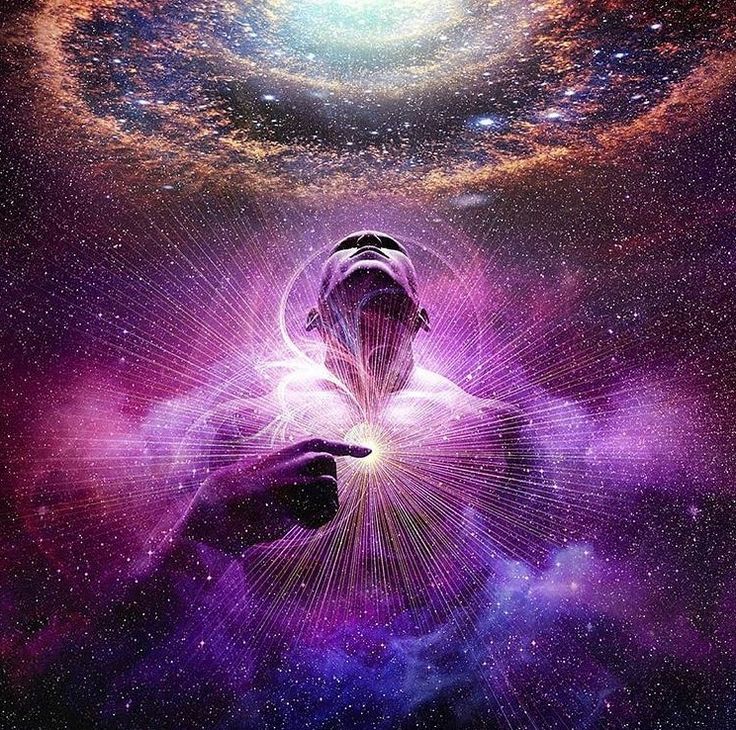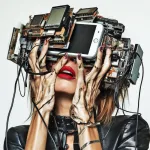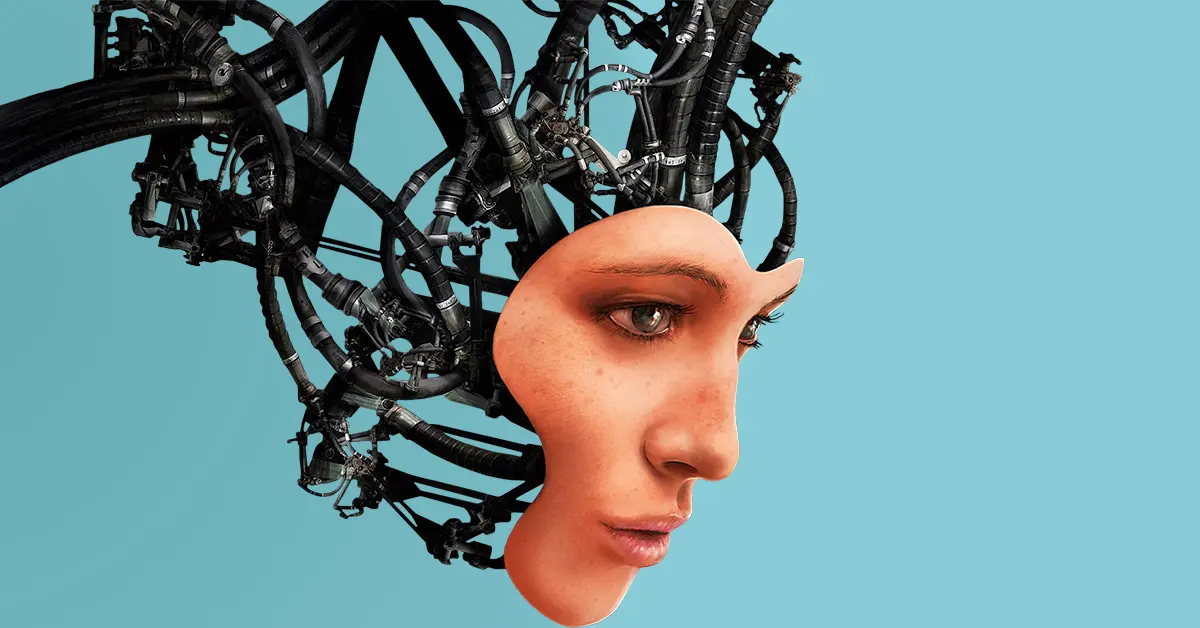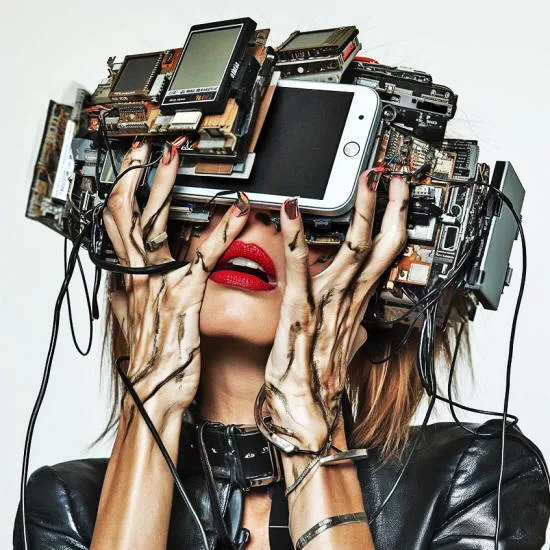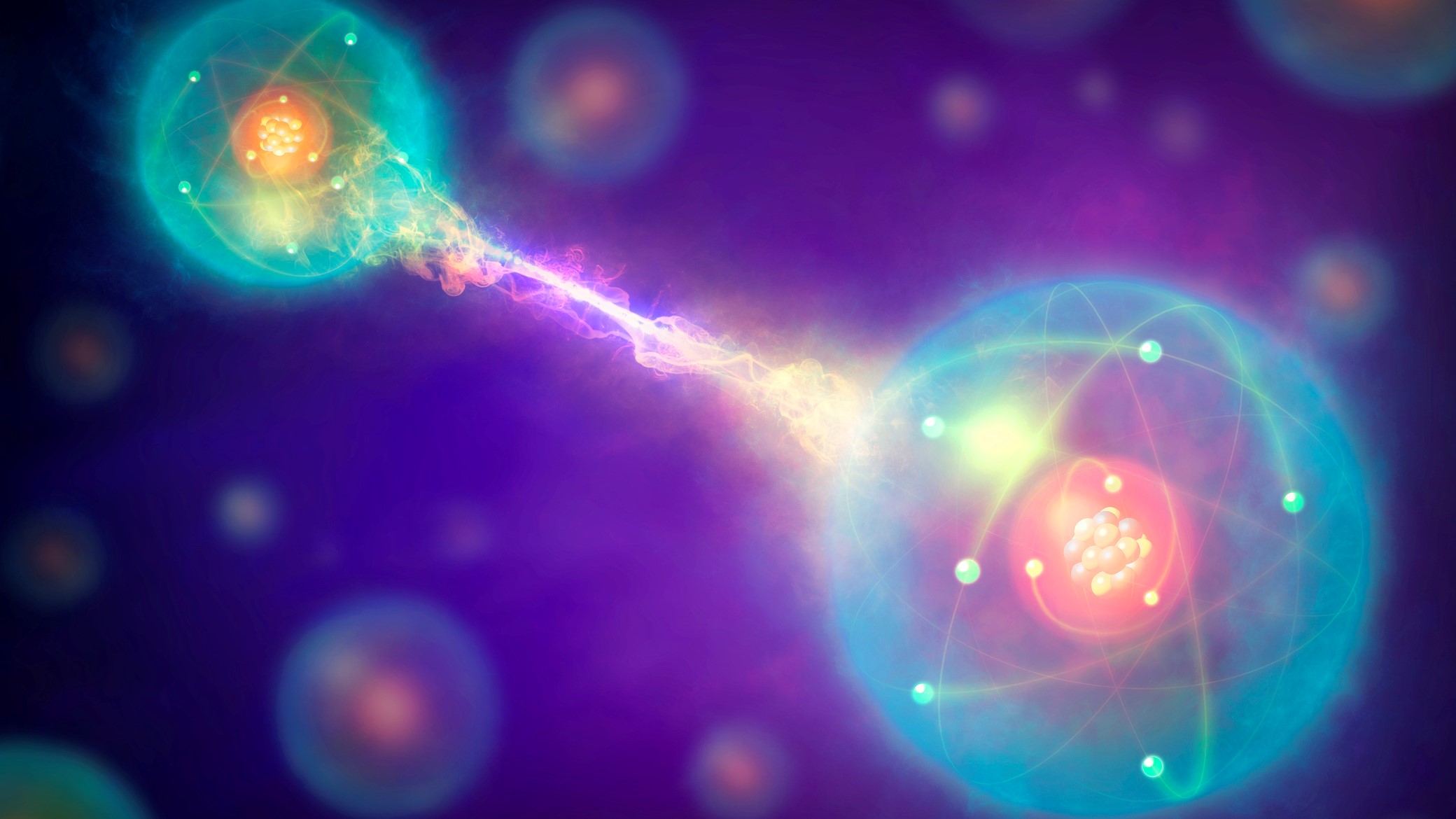by Chip Walter
excerpted from Thumbs, Toes, and Tears
October 25, 2006
from Kurzweilai Website
| …We will no longer be Homo sapiens, but Cyber sapiens – a creature part digital and part biological that will have placed more distance between its DNA and the destinies they force upon us than any other animal … a creature capable of steering our own evolution…. |
Today nature has slipped,
perhaps finally,
beyond our field of vision.
O. B. Hardison Jr.
Now after six million years of evolution, where do we go next? How will evolution, our newly arrived intellect, our primal drives and the powerful technologies we continually create, change us?
Our current situation is unlike anything nature has seen before because we are not simply a by-product of evolution, we are ourselves now an agent of evolution. We are this animal, filled with ancient emotions and needs, amplified by our intellects and a conscious mind, embarking on a new century where we are creating fresh tools and technologies so rapidly that we are struggling to keep pace with the very changes we are bringing to the table.
Where will this lead?
Will we develop new brain modules, new appendages, revamped capabilities just as we have over the past six million years? Absolutely, but probably not in the way we suspect.
It appears, if we look closely, that the DNA that has been such a perfect ally in the evolution of life, may itself be in for a revamping. Evolution may be prowling for a new partner. And the partner may be us, or at least the technologies we make possible.
The irony is that it takes a being like us, a human being, to bring about change this fundamental.
The job requires an amalgamation of high intelligence and emotion, conscious intent, primal drives and great quantities of knowledge made possible by minds that can communicate in highly complex ways. If you pulled any one of these out, the future, at least one involving intelligent, conscious creatures like us, would fall apart.
It takes not just cleverness, but passion, sometimes fear, fired by focused intention, to create and invent.
Without this combination there would be no technologies, no wheels or steam engines or nuclear bombs or computers. And there would be nothing like the world we live in today. At best we would still be huddled in the black African night, eking out whatever existence the predators waiting in the darkness around us would allow.
Not even fire would be our friend.
But the traits that have shaped us into the human beings we are have endowed us with strange abilities, and they are hurtling us into a future radically unlike the past out of which we have emerged. And that future will be profoundly different from anything most of us can imagine.
Take the thinking of Hans Moravec as an object lesson.
Moravec is a highly respected robotics scientist at Carnegie Mellon University. In the late 1980s, he quietly passed his spare time writing a book that predicted the end of the human race.
The book, entitled Mind Children, didn’t predict that we would destroy ourselves with nuclear weapons or rampant, self-inflicted diseases, or undo the species with self-replicating nanotechnology. Instead, Moravec, who had an abiding and life-long fascination with intelligent machines, predicted we would invent ourselves out of existence, and robots would be the technology of choice.
In a subsequent book (Robot, Mere Machine to Transcendent Mind) Moravec explained that this transformation would unfold one technological generation at a time, and, because of the blistering rate of change today, would pretty much run its course by the middle of the 21st century.
We would manage this by boosting robots up the evolutionary ladder, roughly in decade-long increments, making them smarter, more mobile, more like us. First they would be as intelligent as insects or a simple guppy (we are about there right now), then lab rats, then monkeys and chimps until, finally one day, the machines would become more adept and adaptive than their makers.
That, of course, would quickly raise the question:
“Now who is in charge?”
- Would Homo sapiens, after some 200,000 years living on top of the planet’s food chain, no longer rule the roost?
- Would we, in the cramped space of this evolutionary ellipsis, find ourselves playing Neanderthal to technologies that had become, like us, self-aware – the first conscious tools built by a conscious tool-making creature?
The unavoidable answer would be, yes.
Evolution will have found through us a new way to make a new creature; one that could forsake its ladders of DNA and the fragile, carbon-based biology that nature had been using for nearly four million millennia to manage the job.
The “end” would not come in the form of a Terminator style invasion, it would simply unfold in the natural course of evolutionary events where one species, better adapted to its environment replaces another that is no longer very fit to continue. Except the new species wouldn’t be cobbled out of DNA, it would be fashioned from silicon, alloy, and who knows what else, invented by us. But once successfully invented, we wouldn’t be necessary any more.
Whether events will play out like this or not remains to be seen.
But Moravec’s scenario makes a point – the world and the life upon it changes, and simply because we are the agents of change, doesn’t mean we won’t be affected by it.
***
It is strange to think of the invention of machines, even robotic ones, as having anything to do with Darwin’s natural selection.
We usually regard evolution as biological – a world of cells, DNA and “living” creatures. And we think of our machines as unalive, unintelligent and shifted by economic forces more than natural ones. But it isn’t written anywhere that evolution has to be constrained by what we traditionally think of as biology. In fact each day the lines between biology and technology, humans and the machines we create are blurring.
We are already part and parcel of our technology.
Since the day Homo habilis whacked his first flint knife out of flakes of flint, it has been difficult to know whether we invented our tools or our tools invented us. The world economy would crash if its computer systems failed. We can’t live without laptops, palmtops, cell phones or iPods, which grow continually smaller and more powerful.
We regularly engineer genes, despite the raging debates over stem cell therapy. A human being will very likely be cloned within the next five years. We now have computer processors working at the nano (molecular) level and microelectromechanical machines (MEMS) that operate at cellular dimensions. Already electronic prosthetics make direct connections with human nerves, and electronic brain implants for Parkinson’s disease and weak hearts are common place. Scientists are even experimenting with electronic, implantable eyes.
New clothing weaves digital technologies into their fiber and brings them a step closer to being a part of us. The military are working on “battle-suits” that will fit like gloves, a kind of second skin and amplify a soldier’s senses, strength and ability to communicate, even triangulate the direction of a bullet headed his or her way.
What next? Speech, writing and art enabled us to share inner feelings in new and powerful ways.
But it takes months or years to learn a new language or how to play the piano or master the art of engineering bridges and buildings.
- Will new technologies that accelerate communication (virtual reality, telepresence, digital implants, nanotechnology) create new ways to communicate that can by-pass speech?
- Will we someday communicate by a kind of digital telepathy, downloading information, experiences, skills, even emotions the way we download a file from the Internet to our laptop?
- Will we become machines, or will machines become more powerful versions of us?
- And if any of this comes to pass, what ethical issues do we face?
- At what point to do we stop being human?
Lynn Margulis, probably the world’s leading microbiologist, has argued that this blurring of technology and biology isn’t really all that new.
She has observed 1 that the shells of clams and snails are a kind of technology dressed in biological clothing. Is there really that much difference between the vast skyscrapers we build or the malls in which we shop, even the cars we drive around, and the hull of a seed?
Seeds and clam shells, which are not alive, hold in them a little bit of water and carbon and DNA, ready to replicate when the time is right, yet we don’t distinguish them from the life they hold. Why should it be any different with office buildings, hospitals and space shuttles?
Put another way, we may make a distinction between living things and the tools those things happen to create, but nature does not.
The processes of evolution simply witness new adaptations and preserve those that perform better than others. That would make Homo habilis’s first flint knife a form of biology as sure as a clamshell, one that set our ancestors on a fresh evolutionary path just as if their DNA had been tweaked to create a new, physical mutation, say an opposable thumb or a big toe.
Even if these technological adaptations were outside what we might consider normal biological bounds, the effect was just as profound, and far more rapid. In an evolutionary snap, that first flint knife changed what we ate and how we interacted with the world and one another. It enhanced our chances of survival. It accelerated our brain growth which in turn allowed us to create still more tools which led to yet bigger brains.
And on we went, continually and with increasing speed and sophistication, fashioning progressively more complex technologies right up to the genetic techniques that enable us to fiddle with the self-same ribbons of our chromosomes that made the brains that conceived tools in the first place. If this is true, all of our technologies are an extension of us, and each human invention is really another expression of biological evolution.
Moravec and Margulis aren’t alone in asking questions that force us to bend our traditional thinking about evolution.
Scientist and inventor Ray Kurzweil has, like Moravec, pointed out that the rate of technological change is increasing at an exponential rate. Also like Moravec, he foresees machines as intelligent as we are evolving by mid century. Unlike Moravec he doesn’t necessarily believe they will arrive in the form of robots.
Initially Kurzweil sees us reengineering ourselves genetically so that we will live longer and healthier lives than the DNA we were born with might normally allow. We will first rejigger genes to reduce disease, grow replacement organs, and generally postpone many of the ravages of old age. This, he says, will get us to a time late in the 2020s when we can create molecule-sized nanomachines that we will program to tackle jobs our DNA never evolved naturally to undertake.
Once these advances are in place we will not simply slow aging, but reverse it, cleaning up and rebuilding our bodies molecule by molecule. We will also use them to amplify our intelligence; nestling them among the billions of neurons that already exist inside our brains. Our memories will improve; we will create entirely new, virtual experiences, on command, and take human imagination to levels our currently unenhanced brains can’t begin to conceive.2
In time (but pretty quickly) we will reverse engineer the human brain into a vastly more powerful, digital version.
This view of the futures isn’t fundamentally different from Moravec’s brain-to-robot download, except it is more gradual. Either way we will have melded with our technology if, in fact, those barriers ever really existed in the first place, and in the end, erase the lines between bits, bytes, neurons and atoms.
Or looked at another way, we will have evolved into another species.
We will no longer be Homo sapiens, but Cyber sapiens – a creature part digital and part biological that will have placed more distance between its DNA and the destinies they force upon us than any other animal. And we will have become a creature capable of steering its own evolution (“cyber” derives from the Greek word for a ship’s steersman or navigator – kybernetes). The world will face an entirely new state of affairs.
Why would we allow ourselves to be displaced? Because in the end, we won’t really have a choice. Our own inventiveness has already unhinged our environment so thoroughly that we are struggling to keep up. In a supreme irony we have created a world fundamentally different from the one into which we originally emerged.
A planet with six and a half billion creatures on it, traveling in flying machines every day by the millions, their minds roped together by satellites and fiber optic cable, rearranging molecules on the one hand and leveling continents of rain forest on the other, growing food and shipping it overnight by the trillions of tons – all of this is a far cry from the hunter-gatherer, nomadic life for which evolution had fashioned us 200,000 years ago.
So it seems the long habit of our inventiveness has placed us in a pickle. In the one-upmanship of evolution, our tools have rendered the world more complex and that complexity requires the invention of still more complex tools to help us keep it all under control. Our new tools enable us to adapt more rapidly, but one advance begs the creation of another, and each increasingly powerful suite of inventions shifts the world around us so powerfully that still more adaptation is required.
The only way to survive is to move faster, get smarter, change with the changes, and the best way to do that is to amplify ourselves eventually right out of our own DNA so we can survive the new environments – physical, emotional and mental – that we keep recreating.
Is all of this too implausible to consider? Will Homo sapiens really give way to Cyber sapiens that seamlessly integrate the molecular and digital worlds just as our ancestors merged the technological and biological worlds two million years ago?
Evolution has presided over stranger things. It took billions of years before the switching and swapping of genes brought us into existence. Our particular brain then took 200,000 years to get us from running around in skins with stone weapons to the world we live in today. Evolution is all about the implausible. And the drive to survive is a relentless shaper of the seemingly impossible. We ourselves are the best proof.
If all of this should happen; if DNA itself goes the way of the dinosaur, what sort of creature will Cyber sapiens be?
In some ways we can’t know the answer anymore than Homo erectus could imagine how his successors would someday create movies, invent computers and write symphonies.
Our progeny, our “mind children,” will certainly be more intelligent with brains that are both massively parallel, like the current version we have, and unimaginably fast.
- But what of those primal drives that we carry inside our skulls, and those non-verbal, unconscious ways of communicating?
- What of laughter and crying and kissing?
- Will Cyber sapiens know a good joke when he hears one, or smile appreciatively at a fine line of poetry?
- Will he tousle the machine made hair of his offspring, hold the hand of the one he loves, kiss soulfully, wantonly and uncontrollably?
- Will there be a difference between the “brains” and behaviors of he and she?
- Will there even be a he and a she?
- And what of pheromones and body language and nervous giggles?
Maybe they will have served their purpose and gone away…
- Will Cyber sapiens sleep, and if they do, will they dream?
- Will they connive and gossip, grow mad with jealousy, plot and murder?
- Will they carry with them a deep, if machine made, unconscious that is the dark matter of the human mind, or will all of those primeval secrets be revealed in the bright light cast by their newly minted brains?
We may face these questions sooner than we imagine. The future gathers speed every day.
I’d like to think the evolutionary innovations and legacies that have combined to make us so remarkable, and so human, won’t be left entirely behind as we march ahead. Perhaps they can’t be. After all, evolution does have a way of working with what is already there, and even after six million years of wrenching change, we still carry with us the echoes of our animal ancestors.
Maybe the best of those echoes will remain.
After all, as heavy as some baggage can be, preserving a few select pieces might be a good thing, even if we are freaks of nature.
References
1. This was during a conversation with Professor Margulis at her home in western Massachusetts.
2. Note: the current version of a creature can never comprehend the experience of the creature that will follow because it does not yet have the evolved capacity (whatever it is) that will make that experience possible. We cannot accurately imagine what a digitally enhanced brain will conceive any more than Homo erectus could imagine our experience of the world.

by Dawn Bailey,
May 13, 2018
from In5D Website

I wrote about 5th dimensional negative energy and higher that I look for when helping someone.
These energies will leave you alone until right before ascension to the 5th. They try and hold you down from ascending by lowering your vibration.
I am now going to go into the 4th dimensional energies to watch out for. These, of course, are meant to keep you from raising your vibration for ascension too.
- Demons and Entities are the ones most are familiar with. There are different ones, but they all do the same. They cause negative emotions and thoughts that can mentally wear you down. They can be very painful to those that feel energy. They exaggerate your feelings and can cause you to act out of character. Perhaps they might make you say something or act in a way that isn’t you, but will not be able to stop yourself. Once removed, you will go back to normal behavior.
- Jinn are a type of demon, but these can get into your electronics and cause some crazy problems. They do attach to people, also. They have the ability to leave and come back so they can sometimes be tricky to find and catch.
- Etheric weapons and objects. These don’t move around and stay in a small, concentrated area. They can be quite painful to those that feel energy.
- Suppression Parasite Entities (SPE) and Super Imposed Influences (SII) are meant to lower your vibration by exaggerating your negative thoughts and emotions. I feel SPE’s as a dull, throbbing pain in a small area, usually on my back. I feel SII’s as a heavy pressure on my shoulders, almost as someone having their hands on my shoulders and pushing down on them with their hands.
- Discarnate Souls are earth bound souls that never crossed over and are trapped on earth due to unresolved karma. Ghosts fit in this category. They will be attracted to people who have the same unresolved karma as they did when living, such as addictions, anger problems, etc…
- Elementals are nature spirits that also live in the lower world, too. Most are not harmful, such as fairies or pixies. One to look out for is the wraith. Wraiths are black, sticky, and oozy with hooks that attach to the back and spread out, eventually wrapping and hooking around someone’s meridians.
- Goblins are mischievous and don’t hurt you but will try and scare you. For example, things might get thrown around your house or doors may open and close by themselves. They like to hide in cabinets and closets. My first encounter with one in my house was scary. It went around knocking stuff over and then, when I opened a cabinet, a plastic cup was thrown at me. It missed me because they can’t hurt you, only scare you. I shut all my windows but one and ordered it to leave out the open window, and it did.
- Incubus/Succubus are demons that attach to women and men, eventually causing sex addictions and sexually demeaning behavior. I have know a few men and one woman with these demons. They can cause risky harmful sexual behavior, such as sex addictions and promiscuity that causes a person to suffer.
- Hex’s, Curses, Spells, Bindings, and Petitions are forms of witchcraft. My problem with witchcraft is that almost everything I have seen is designed to interfere with another persons freewill or cause harm. A spell or curse is a form of intent that sends out a negative thought form, harmful entity, or pattern. If you have a string of unbelievable bad luck, it could be caused by a hex. One lady I helped had all her bank accounts drained, her credit cards stolen and ran up, and a car accident, all in a week. I knew two ladies that practiced Wicca. The number one rule of Wicca is cause no harm, but these ladies ignored that rule. They used to be friends and ran a metaphysical shop together. They had a falling out and were no longer friends or partners. Since I knew both, I knew they were doing some witchcraft to each other. One of them even showed me the doll she had bound to bind her ex friend and partner. Eventually both these ladies had massive health problems and got very sick. Whatever you send to another person comes back to you worse than what you sent.
This is a universal law that no one can avoid.
All negative energy is designed to cause suffering and distractions from you living your purpose. Everyone has the capability to heal themselves. Stay on your path and you will find your own way to heal until you find your own healing method that works for you.
You may need to have some help, perhaps from a healer. I went to a healer before I learned how and she helped me. I learned my own method by watching her work on me.
Just like going to a doctor for physical illnesses, you may need to go to a healer for spiritual illnesses.
Shamans, energy healers, or reiki practitioners are here to help you along your journey. It is also important to follow daily spiritual cleansing practices.
Just like showering every day, you need to take care of your aura and chakras, too.
Someone with blocked chakras and a weak aura are much easier for them to attach to. If you feel drained of energy and in a negative mindset, get your spiritual health checked.
Spiritual imbalances, if left too long, can manifest into physical illnesses…
by Michael Salla
March 01, 2018
from ExoNews Website
A February 28 report by the New York Times describes how Barbara Streisand paid $50,000 to have two clones made of her favorite pet dog that passed away last year.
The story reveals how open source cloning has been quietly developed in scientific laboratories over the last 20 years, and is opening the door to human cloning becoming a reality in the near future.
This is not a surprise given multiple whistleblower claims that human cloning was developed by the 1970’s in highly classified military projects.
The New York Times describes how cloning has evolved since “Dolly the Sheep” who was born in 1996. The New York Times tracks how research shifted over years to clone,
“about two dozen other mammal species, including cattle, deer, horses, rabbits, cats, rats – and yes, dogs.”
The first dog was cloned in 2005 by South Korean researchers at Sooam Biotech.
This was followed in 2008 by a California company partnering with the South Koreans which successfully cloned three puppies from a group of five dogs.
By 2015, Sooam Biotech, had cloned over 600 dogs according to reports from Business Insider and NPR.
The lead Korean scientist behind the cloning is Hwang Woo Suk, who became infamous for fraudulently claiming he had cloned human embryos in 2004. Despite his fall from scientific grace, no one is doubting that he is successfully cloning dogs.
NPR reports that the cloning process is successful in about one in three attempts, and raises many ethical concerns about the number of miscarriages and the sickly pups that are eventually born.
This did not deter Streisand who used either Sooam Biotech or another Texas based company, her publicist did not reply to the New York Times about which one cloned her dog.
The New York Times summarized an interview Streisand gave with Variety Magazine about her two cloned puppies, which suggested she was satisfied with the results:
In her interview with Variety, Ms. Streisand revealed that two of her three Coton de Tulear dogs were clones.
Specifically, the magazine reported that the dogs – Miss Violet and Miss Scarlett – had been cloned from cells taken from the mouth and stomach of Ms. Streisand’s late dog Samantha, who was 14 when she died last year.
Miss Violet and Miss Scarlett,
“have different personalities,” Ms. Streisand told Variety.
“I’m waiting for them to get older so I can see if they have her brown eyes and her seriousness.”
| https://www.youtube.com/embed/XMQRSPbS1pU |
The fact that over 600 dogs have been cloned so far by a Korean researcher made infamous for claims about cloning humans, suggests it is only a matter of time before human cloning becomes a reality.
However, according to a number of whistleblowers, cloning has been occurring since at least the 1970’s.
Dr Peter Beter was appointed by President John F. Kennedy to serve as General Counsel for the Export-Import Bank of the United States, a position he held from 1961 to 1967.
In an audioletter dated May 28, 1979, Dr. Beter said:
Clones of all kinds of animals have been produced successfully in the laboratory, but that is not what bothers people. In the recent past it has been claimed that human clones are also possible and that some may already be in existence.
These last claims about human clones have been ridiculed, denied, and suppressed by all kinds of officials–the reason is that the idea of duplicate human beings impinges upon a super-secret realm of Intelligence activities by both Russia and the United States.
It’s noteworthy to point out that animal cloning according to Dr. Beter was occurring at least 20 years before Dolly the Sheep in highly classified research projects.
It is the claims of Michael Wolf that are next worth considering since he says he was involved in the creation of the first human clone in a classified research facility.
Chris Stonor wrote an article summarizing an interview with Wolf in October 2000:He was involved in various genetic experiments – one being the Sentinel Project.
After perfecting cloning techniques on animals Dr Wolf and his associates successfully created an artificially-intelligent human named ‘J-Type Omega’ – their superiors wanted a superbright, superpowerful soldier who would follow orders without fear or question.
But Dr Wolf surreptitiously programmed ethics into its intelligence after realizing that ‘J Type’ had a soul…
The Sentinel Project involved a close association with the ‘Greys‘. The ETs vast knowledge on genetics being essential for its success. ‘J Omega’ was grown in a water tank from an embryo.
Part of the DNA used came from Dr Wolf.
It took exactly one year before he was ready to be ‘awoken’.
In Wolf’s 1993 book, The Catchers of Heaven, he explained how he was instructed to terminate the clone since it refused to follow an order by his military superiors to kill a dog:
Of course, man has always wanted to create a being in his own image…
We can do it now. We have done it! He was terminated, however, because he couldn’t follow orders; he couldn’t shoot an animal. This being told the big brass that I said: “People do not do things unless there’s a good reason to do it.
I see no good reason to kill this harmless dog.
The Catchers of Heaven, p. 9
Wolf asserted that from 1972 to 1977 he worked on highly classified at the S-4 facility at Papoose lake, and Area 51 more generally. It was during this period that the J Omega human clone was allegedly created.
Other more recent whistleblowers who have come forward to claim that human cloning has been around for decades in classified projects include,
It is generally accepted that classified research projects are typically two or three decades ahead of their open sources equivalents.
Therefore, the revelations of Beter, Wolf, Tompkins, Goode and Smith concerning the existence of human cloning experiments going as far back as the 1970’s, if not earlier, have just been scientifically vindicated by the New York Times story.
The fact that animal cloning is now available for those willing to pay $50,000 for former pets, raises the likelihood than in the very near future, people will be asked to pay similar or higher fees for clones of former relatives, persons of interest, or even themselves.
It’s very likely that the New York Times story on Streisand is preparing the general public for human cloning as a future commercial enterprise, despite the many ethical issues it raises…

